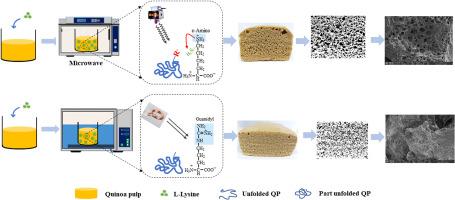碱性氨基酸对微波处理的无麸质藜麦海绵蛋糕质构特性的调节
IF 11
1区 农林科学
Q1 CHEMISTRY, APPLIED
引用次数: 0
摘要
在藜麦粉中添加赖氨酸(Lys)和精氨酸(Arg)(0.6%)可改善经不同加热方法处理的无麸质海绵蛋糕的质地质量和物理特性。与水浴(WB)处理相比,强化了 Lys 和 Arg 的无筋海绵蛋糕提高了细胞密度和表面积分数,微波(MW)处理进一步增强了这些效果。此外,微波结合 Lys 处理显示了海绵蛋糕的最佳质地特性。通过 1H NMR 测定的水分分布表明,水分子与蛋白质网络结构结合在一起。傅立叶变换红外光谱证明,MW 与 Lys 的结合促进了藜麦海绵蛋糕中蛋白质从无序结构向有序结构的转变,增强了蛋白质分子的膨胀和疏水区域的暴露,从而促进了蛋白质的聚集。SDS-PAGE显示,当碱性氨基酸存在时,它们能在MW交变电场下调节蛋白质分子的有序聚集,从而增强分子间的相互作用。最后,通过扫描电镜对微观结构的评估表明,MW 与碱性氨基酸的结合形成了稳定的三维凝胶网络结构,从而提高了无麸质藜麦海绵蛋糕的质量。因此,研究结果表明,使用 MW 改善无筋藜麦食品的物理和质构质量是可行的。本文章由计算机程序翻译,如有差异,请以英文原文为准。

Modulation of textural properties in microwave treated gluten-free quinoa sponge cake by alkaline amino acids
Lysine (Lys) and Arginine (Arg) (0.6%) was added to the quinoa flour to improve the textural quality and physical properties of gluten-free sponge cake treated with different heating methods. The gluten-free sponge cake fortified Lys and Arg increased cell density and surface area fraction, compared to water bath (WB) treatment, with the microwave (MW) treatment further enhancing these effects. Furthermore, MW combined Lys treatment showed the best texture characteristics of sponge cake. The water distribution determined by 1H NMR presented that water molecules are bound by the protein network structure. FTIR spectrum proved MW combined with Lys promoted the transition from disordered structure to ordered structure of protein in quinoa sponge cake, which enhanced the expansion of protein molecules and the exposure of hydrophobic regions, thus promoting protein aggregation. SDS-PAGE revealed when alkaline amino acids were present, they can regulate the ordered aggregation of protein molecules under MW alternating electric field, leading to enhanced intermolecular interactions. Finally, microstructure evaluations by SEM demonstrated MW combined with alkaline amino acids formed a stable three-dimensional gel network structure, thus improving the quality of gluten-free quinoa sponge cake. Therefore, the study findings pointed to the feasibility of using MW to improve the physical and textual quality of quinoa gluten-free food.
求助全文
通过发布文献求助,成功后即可免费获取论文全文。
去求助
来源期刊

Food Hydrocolloids
工程技术-食品科技
CiteScore
19.90
自引率
14.00%
发文量
871
审稿时长
37 days
期刊介绍:
Food Hydrocolloids publishes original and innovative research focused on the characterization, functional properties, and applications of hydrocolloid materials used in food products. These hydrocolloids, defined as polysaccharides and proteins of commercial importance, are added to control aspects such as texture, stability, rheology, and sensory properties. The research's primary emphasis should be on the hydrocolloids themselves, with thorough descriptions of their source, nature, and physicochemical characteristics. Manuscripts are expected to clearly outline specific aims and objectives, include a fundamental discussion of research findings at the molecular level, and address the significance of the results. Studies on hydrocolloids in complex formulations should concentrate on their overall properties and mechanisms of action, while simple formulation development studies may not be considered for publication.
The main areas of interest are:
-Chemical and physicochemical characterisation
Thermal properties including glass transitions and conformational changes-
Rheological properties including viscosity, viscoelastic properties and gelation behaviour-
The influence on organoleptic properties-
Interfacial properties including stabilisation of dispersions, emulsions and foams-
Film forming properties with application to edible films and active packaging-
Encapsulation and controlled release of active compounds-
The influence on health including their role as dietary fibre-
Manipulation of hydrocolloid structure and functionality through chemical, biochemical and physical processes-
New hydrocolloids and hydrocolloid sources of commercial potential.
The Journal also publishes Review articles that provide an overview of the latest developments in topics of specific interest to researchers in this field of activity.
 求助内容:
求助内容: 应助结果提醒方式:
应助结果提醒方式:


